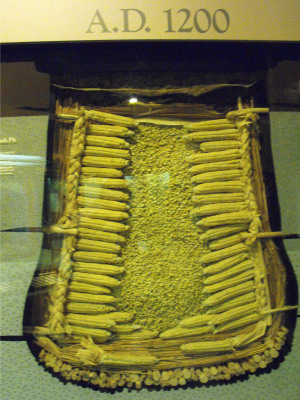
Paleoethnobotany of eastern Native Americans
 It's
amazing how finding the right words expedites research. Ever
since I learned that modern
forest gardening is based on traditional
farming practices in the tropics, I've wondered "What do
Native
Americans from my own neck of the woods have to teach us?"
Delving into North American native agriculture, I quickly learned that
corn dominated the area's fields and diet in a near monoculture for the
last thousand years, causing health problems I don't want to
repeat. But
corn had only travelled north from Mexico in the last couple of
millenia --- what did
people around here eat before that?
It's
amazing how finding the right words expedites research. Ever
since I learned that modern
forest gardening is based on traditional
farming practices in the tropics, I've wondered "What do
Native
Americans from my own neck of the woods have to teach us?"
Delving into North American native agriculture, I quickly learned that
corn dominated the area's fields and diet in a near monoculture for the
last thousand years, causing health problems I don't want to
repeat. But
corn had only travelled north from Mexico in the last couple of
millenia --- what did
people around here eat before that?
During our visit to Sunwatch, I splurged on a couple of
books, one of
which was a type-written and home-bound writeup of the archaeological
history of the site, not so succinctly titled A
History of 17 Years of Excavation and Reconstruction --- A Chronicle of
12th Century Human Values and the Built Environment: Volume 1. Can you blame me that I put
this tome on a back shelf for a cold winter day?
 If
I'd opened this remarkably easy to read volume back in the summer,
though, I would have shortened my research journey considerably.
The text
provides an overview of not only the diets of the Sunwatch inhabitants
(living in
the era of corn), but a comparison with the diets of people who lived
in the same area before corn became king. Best yet, one chapter
is entitled "Paleoethnobotanical Research at the Incinerator
Site." Eureka! Using my newfound understanding of the eras
of prehistory in the eastern U.S. and the name of the field, I quickly
found several (also easy to read) scientific and layman's texts about
the paleoethnobotany of Archaic and Woodland Native Americans. If
only I'd known that's what I was looking for eighteen months ago!
If
I'd opened this remarkably easy to read volume back in the summer,
though, I would have shortened my research journey considerably.
The text
provides an overview of not only the diets of the Sunwatch inhabitants
(living in
the era of corn), but a comparison with the diets of people who lived
in the same area before corn became king. Best yet, one chapter
is entitled "Paleoethnobotanical Research at the Incinerator
Site." Eureka! Using my newfound understanding of the eras
of prehistory in the eastern U.S. and the name of the field, I quickly
found several (also easy to read) scientific and layman's texts about
the paleoethnobotany of Archaic and Woodland Native Americans. If
only I'd known that's what I was looking for eighteen months ago!
| This post is part of our Native American Paleoethnobotany lunchtime
series.
Read all of the entries: |
Want more in-depth information? Browse through our books.
Or explore more posts by date or by subject.
About us: Anna Hess and Mark Hamilton spent over a decade living self-sufficiently in the mountains of Virginia before moving north to start over from scratch in the foothills of Ohio. They've experimented with permaculture, no-till gardening, trailersteading, home-based microbusinesses and much more, writing about their adventures in both blogs and books.
Want to be notified when new comments are posted on this page? Click on the RSS button after you add a comment to subscribe to the comment feed, or simply check the box beside "email replies to me" while writing your comment.
- Remove comment
- Remove comment
